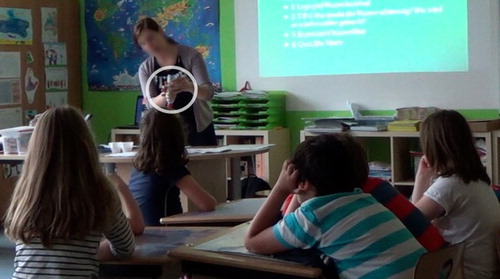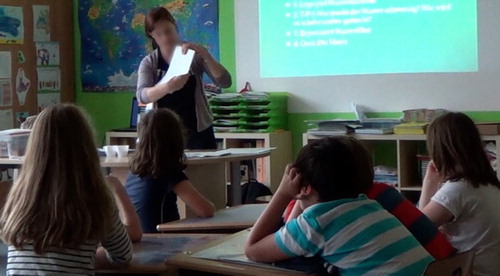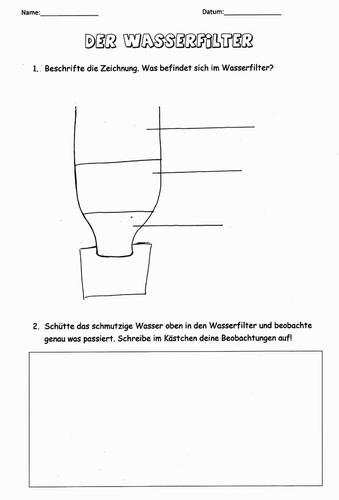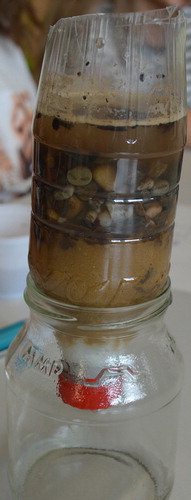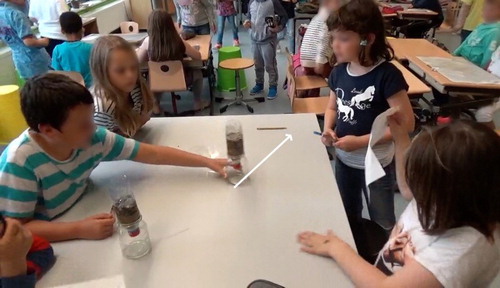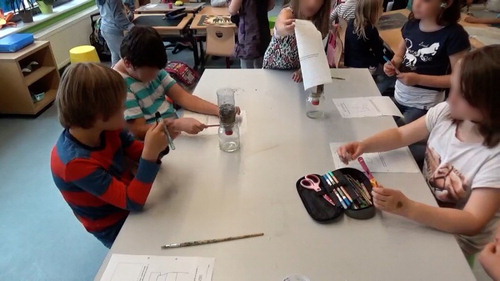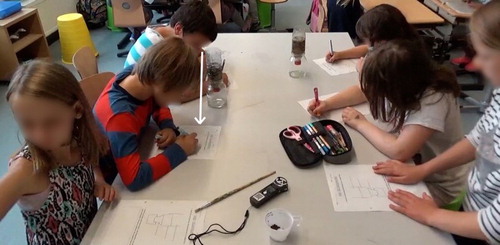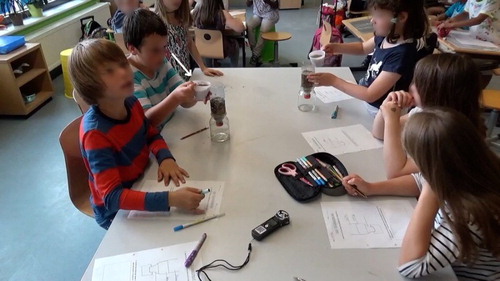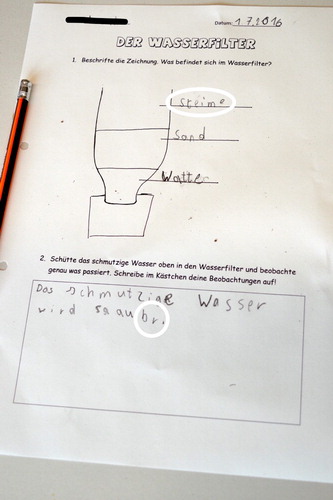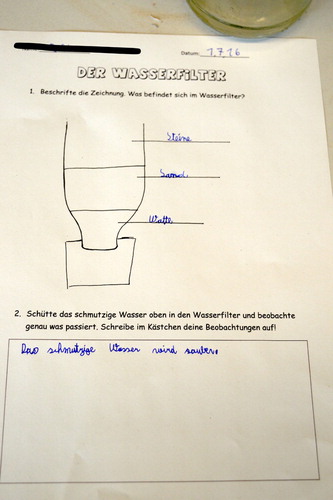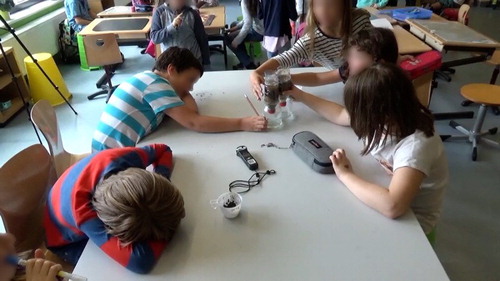ABSTRACT
Culturally and linguistically diverse (CLD) students have different home languages and cultures from many of their peers, In our context, these students suffer from higher school drop-out rates than their peers and are far behind their peers in sciences. This study investigates the interactions of a nine-year-old child whose home language is Portuguese and who learns science in this specific case in a diglossic environment in the Luxembourgish school system, in which his teacher used German for written tasks and Luxembourgish for oral communication. We examine, moment-by-moment, the interactions around a task regarding environmental protection. The role of this Lusoburguês (Luxembourgish and Portuguese identities and nationalities combined) student and his embodiment and participation changes when his group is confronted with an activity that requires an increased amount of manipulation. His identity evolves in interaction, as he becomes the leader in his group, and through a playful stance, manages to open the task so that his peers can further explore. Implications include the value of including more open-ended investigations in the teaching and learning of science as well as implications for further study concerning practice-based approaches in science classrooms with CLD students, particularly in increasingly multilingual/cultural and/or diglossic or heteroglossic school contexts.
Introduction: CLD students and science education
Culturally and linguistically diverse students (CLD students), who may have different home languages and cultural backgrounds from their peers and/or teachers, have been shown to be disadvantaged academically (e.g. Vang, Citation2005) especially in science (García, Kleifgen, & Falchi, Citation2008; The Organisation for Economic Co-operation and Development [OECD], Citation2013). For these students, traditional teacher-led instruction in sciences can be counterproductive (Freeman et al., Citation2014) and thus there has been an identified benefit of open-ended structures (Siry, Citation2013) within science investigations. We use the term open-ended to represent investigations for which more than one outcome is possible (Lock, Citation1990), and such approaches have proven benefits for effective science learning for CLD students and students from disadvantaged backgrounds (Haak, HilleRisLambers, Pitre, & Freeman, Citation2011; Lee et al., Citation2016), resulting ideally in a more equitable curriculum (Harlen, Citation2012). In this paper, we examine data resources focusing on a second-grade classroom with a high percentage of CLD students to consider what is accomplished in interaction, in order to emerge with claims on the role of science investigating for multilingual/cultural classrooms with the aim of engaging CLD students in science practices and thus improving their chances to succeed.
Theoretical framework: an integrated approach
We embrace multiple theoretical perspectives in our work, and draw on sociocultural theories to make sense of the ways in which science teaching and learning occurs in classroom contexts (e.g., Siry, Ziegler,& Max,Citation2012; Tobin, Citation2013). By layering theories together, we emerge with an integrated theoretical approach to guide our co-researching and co-writing. Multi-theoretical approaches allow us to draw on different interrelated theories to better understand the complexities of learning and teaching processes around science. As such, the analyses herein are grounded in a framework that considers the role of identities within the ‘doing’ of science and the use of diverse approaches for structuring science investigations with children, introduced next. Through the analysis of the data, we examine how one student’s participation in a series of group investigations shifted from a peripheral role to a more central one, and we consider the structures of the tasks of the investigations to emerge with claims regarding his engagement in the investigations.
Identities in science education
We understand identity and learning as inseparable entities, and identity as constructed, fluid, and dynamic (Holland, Lachicotte, Skinner, & Cain, Citation1998). Identities shift and change in interaction, and as such, learning itself involves changes in identity, which can be observed in moment-to-moment interactions as well as on a more longitudinal level. One theoretical perspective that is useful for examining how learning and identities shift and change is situated learning theory (Lave & Wenger, Citation1991), where learning is understood as a change in identity. Lave and Wenger’s Legitimate Peripheral Participation provides a lens to understand this relationship, in our case, between participation in the practices of science and the identity-related roles of participants in interaction: ‘Because learning, wherever it occurs, is an aspect of changing participation in changing practices’ (Lave, Citation1996, p. 161). Concepts developed by Lave and Wenger (Citation1991), such as legitimate peripherality and access, allow us to better understand critical processes that take place in moment-to-moment participation in the classroom. Lave and Wenger’s work, initially focused on hands-on learning such as apprenticeship in informal contexts (e.g. tailors, midwives), becomes a useful tool to understand the learning of sciences in an applied learning context. In such a framework, knowledge, learning, participation, and identity are interrelated: ‘Knowing is inherent in the growth and transformation of identities and it is located in relations among practitioners, their practice, the artifacts of that practice, and the social organization and political economy of communities of practice’ (Lave & Wenger, Citation1991, p. 122). We layer onto this perspective an understanding of the ways in which people position themselves, and are positioned, in interactions.
To explain changes in embodiment and participation, especially of the speaker, we draw on the notion of ‘footing’, understood as: ‘the alignment we take up to ourselves and the others present as expressed in the way we manage the production or reception of an utterance’ (Goffman, Citation1981, p. 128). Footing describes the interactional positions of participants in an encounter (Wortham, Citation1996) and provides a lens on investigating how these change in and through interactions. In particular, the cues and markers can reveal the footing of participants, and the analysis that follows considers cues and markers (Goffman, Citation1981) that demonstrate how changes in footing led to more central participation in a science investigation. As students become enculturated into a practice such as science education, they come to expect participation frameworks in particular settings (Wortham, Citation1996), yet this understanding of expectations assumes an enculturation that CLD students may not have yet experienced, especially if they are newly arrived at a particular context (Gómez Fernández, Citation2014).
Learning, through the frameworks that we adopt, can be positioned as a ‘transformation of participation within ongoing activity’ (Stromholt & Bell, Citation2017, emphasis in the original), as learners adopt shifting roles that support more central participation in practice (Rogoff, Citation1994). Thus, the ways in which students interact can provide a useful lens for understanding learning as a result of shifting roles in participating in science investigations. In the sections that follow we are guided by these layered theoretical perspectives in considering how one child’s footing changed as his embodied participation in science investigations increased. Specifically, we consider how he becomes a more central participant in an encounter around a science investigation in order to draw implications for more inclusive science approaches that support increased participation, which is a central aspect of ‘doing’, and learning, science.
Practice-based approaches in multilingual/cultural science classrooms
In our context, which we introduce below, the instruction is typically textbook- and worksheet-driven, with teacher-directed instruction, often drawing on verbal and written recall of fact-based information. The role of the students in such teacher-directed science teaching is often passive as ‘conservative science teaching prevents opportunities for students to become epistemic agents’ (Stroupe, Citation2014, p. 488). The structures in such heavily teacher-directed lessons can hinder students taking agency, and this is visible in several ways, including that teachers do not take students’ prior knowledge or meaning-making into account (Stroupe, Citation2014). Participatory instructional approaches can present alternatives for teacher-centred instruction, especially in diverse contexts (Meyer & Crawford, Citation2015). Such approaches are characterised by constructivist views of learning and may lead to ‘strong increases in student performance’ (Freeman et al., Citation2014, p. 8413). At the undergraduate level, Haak et al. (Citation2011) studied whether a STEM course could be modified to improve the performance of students from disadvantaged educational and/or socioeconomic backgrounds. They found that active learning and practice had an impact, and suggested that disadvantaged students are supported with ‘ … not drilling, but exercises that challenge previous conceptions and require students to explain their thinking’ (p. 1216). At the primary school level, research has demonstrated that instructional approaches focused on dialogue and allowing for students’ own investigations can provide space for multilingual students to develop their science understandings along with their language competencies (Wilmes, Siry, Gómez Fernández, & Gorges, Citation2018). Furthermore, so-called ‘open-ended structures’ allow for collaboration between students in their investigations (Siry, Citation2013, pp. 2422–2423).
Numerous studies emphasise the value of more participatory approaches to learning science to support students who might be marginalised by lecture-based approaches, including CLD students. In the U.S. context, Meyer and Crawford (Citation2015) elaborate how inquiry instruction has proven to be successful for English Language Learner (ELL) students but acknowledge that ‘challenges in science learning continue to persist’ for these students (p. 620). Freeman et al. (Citation2014) conducted a meta-analysis on studies focusing on undergraduate STEM students, and found that even though traditional lecturing has dominated in time, approaches that included opportunities for active engagement in STEM courses are related to an increase in student performance. Further, Stromholt and Bell (Citation2017) have demonstrated how opportunities for upper primary school students to engage in authentic practices provided opportunities for identity-related work that shaped the ways in which students were positioned to engage in science and to be viewed by themselves and others. We take inspiration from these authors and connect their research findings on the use of participatory instructional approaches with older CLD students to our own research focusing on younger primary school CLD students in Europe.
Context: a super-diverse student body
Our work is situated in Luxembourg, a country with the highest proportion of the diverse population in Europe, 46.7%, (Institut national de la statistique et des études économiques du Grand-Duché de Luxembourg [STATEC], Citation2016, p. 11) and a multilingual school system. Primary school is taught in Luxembourgish, German, and French, depending on the age of the students and the subject being instructed. To clarify, children attending Kindergarten, which is mandatory for ages 4–6, are taught in Luxembourgish. Once children enter first grade (age 6), the language of instruction is predominantly German, as children learn to read and write in German, with Luxembourgish often used for verbal interaction between teachers and children. In second grade (age 7), children begin to learn French, with increasing focus through primary school (K-6, ages 4–12). represents the nationalities of children attending these tri-lingual public primary schools in Luxembourg, and shows that children holding Luxembourgish nationality represent only approximately half of the total students (Ministère de l’Éducation nationale, de l’Enfance et de la Jeunesse [MENJE], Citation2015, p. 8). This is a trend that has been growing for the last years, with an increasing number of children with nationalities other than Luxembourgish attending public schools. It is also important to clarify that it cannot be assumed that students who are Luxembourgish nationals all speak Luxembourgish as a first language, especially as there is the possibility for people to hold two or more nationalities, whom may well speak Luxembourgish and also other home languages. Furthermore, statistically, children holding Luxembourgish and other nationalities are only counted as Luxembourgish. Therefore, primary school children speaking a language other than Luxembourgish at home represent a higher percentage (62%) than only taking the Luxembourgish nationality of children (51%) into account (MENJE, Citation2016, p. 90) (see ). The highest percentage of non-Luxembourgish children in the schools are Portuguese nationality children, who alone represent 25.7% of the total students in primary education. Children speaking Portuguese as a first language represent 29% of the student population in public primary schools (MENJE, Citation2016). These Portuguese-speaking children constitute the biggest ethnic and linguistic minority in the Luxembourgish school system, as they represent one fourth of the total primary school population. This population suffers from significantly higher school drop-out rates (MENJE, Citation2016) and have been shown to be well behind their colleagues in sciences (OECD, Citation2013, Citation2016) which we discuss next.
Figure 1. Latest data available by cycle concerning public preschool and primary schools in Luxembourg by nationality. Source: Adapted from MENJE (Citation2015, p. 8).
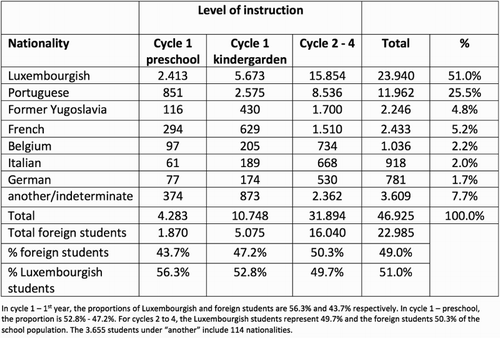
Figure 2. Languages spoken at home by children from age 3 to 12 and its evolution from 2009 until 2015. Source: Adapted from MENJE (Citation2016, p. 90).
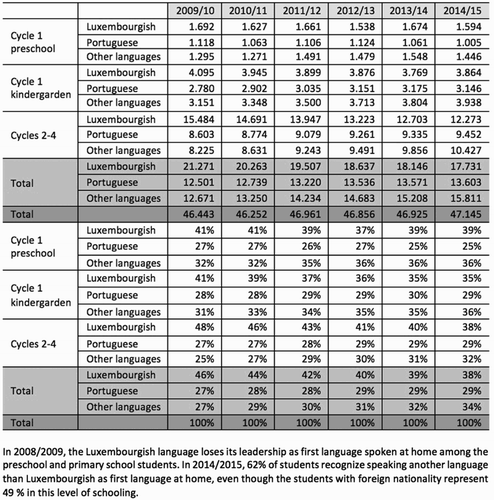
The Luso-luxembourguês minority
Portuguese migrants started coming to Luxembourg approximately 40 years ago (Fleury, Citation2013). Originally from rural, modest families they typically had a low level of education and worked at the lower end of career ladders (Fleury, Citation2013). Adding to this positioning as low-status workers, the first generations migrating to Luxembourg were also at the low end of the linguistic ladder, with limited knowledge of the country’s languages (Valentova & Berzosa, Citation2012). Their relatively low socioeconomic and linguistic levels add to a low intergenerational economic support in comparison to Luxembourgish counterparts (Fleury, Citation2013). Taken together, these factors have a great impact on the second generation or so-called Luso-luxembourguês/Lusoburguês. School-related consequences, for instance, include that many families are not able to support their children with everyday issues at school, such as homework. A limited or non-existent knowledge of German does not allow many Portuguese parents to assist their children with science homework, for instance. Private tutoring in Luxembourg is expensive and many families with lower socioeconomic levels cannot access such support for children.
Recent PISA results for Luxembourg show that by the time lusophone students reach secondary school, they are well behind their Luxembourgish colleagues (OECD, Citation2013). They, together with students from former Yugoslavia, are 84 points away in Sciences from their colleagues, which equals two academic years of study (OECD, Citation2013). The latest PISA results show an improvement for the foreign school population; however, Portuguese nationals still remained between 70 and 86 points away from their counterparts (OECD, Citation2016). Adding to this achievement gap in international assessments, most of these lusophone students are tracked to technical secondary schools when they are 12 years old (MENJE, Citation2016), an early separation system that has been criticised by the Council of Europe [CoE] (MENJE & CoE, Citation2006) because of the repercussions in educational systems with a high percentage of migrants and languages, as in Luxembourg.
Educational policy and the teaching of sciences
Policy documents emphasise that Luxembourgish schools are to be for all students, as also mentioned in the curricula for primary education (MENFPS, Citation2004). Herein it states that schools must support all children, stimulating the strongest but also those less advantaged, with an emphasis on the weakest.Footnote1 Individualising instruction and adapting to students’ needs can provide opportunities to students to achieve their maximum capabilities. The point raised here by the Ministry is extremely important, especially for sciences. Numerous studies claim that a more practice-based approach to science education can offer broader opportunities (e.g. Meyer & Crawford, Citation2015), specifically to CLD students who can benefit from hands-on approaches to science education. While there is this policy emphasis on schools being for all students, there are particular issues that can lead to decontextualised science education experiences that are far removed from the everyday lives of students, in particular of CLD students such as the Lusophone student highlighted herein.
In the analysis that follows, we highlight the role of structures that allow for students to investigate phenomena first-hand, as we examine what emerged in-interaction in a primary school science activity. Open-ended structures, especially where students have the freedom to talk in any language and even translanguage (García, Citation2009), can allow students to better understand concepts they are working with. Our work is situated in a diglossic context, which we have introduced above. Although policy documents state that science should be taught in German, it is often taught in two languages, with Luxembourgish typically used orally and German for writing. Thus, most Lusoburguês children are schooled and learn science in two languages, none of them usually their home language. Their difficulties to speak and, even more so, write, in German are commonly known (Weber, Citation2008). Language plays a major role in the learning of science (Lemke, Citation1990); thus, teaching and learning science, through a more teacher-directed and written mode (in German) without open-ended structures may in principle not assist with meaning-making and achieving academic progress, and possibly even hinder student learning. With this problematic at the fore of our work, we examined the interactions of a second-grade Lusophone student to consider his use of resources (linguistic and other) vis-à-vis open-ended science investigations.
Collecting ethnographic data in a primary school
The primary school in which this research occurred is in a small town with a population just over 1600 inhabitants. The collection of this data was framed under the SciPol:Lux project (Science Education, Innovation, and Policy in Modern Luxembourg)Footnote2 project, which examines the teaching of science in six overarching topics, identified as ‘fields of experience’ in the curriculum. In this paper, we highlight a curricular unit in one of these fields, on the topic of environmental protection. This research was conducted with children ages 8–9 years old. The data resources were collected over five sessions, from April until July 2016. A small group of six children were selected, as we sought to arrive at a deeper understanding of science teaching and learning with these particular students, and they are our initial and embedded unit of analysis to the case of this classroom. One of the six students in this focus group is a Lusoburguês student, aliasFootnote3 ‘Pedro’, who serves as a focal case study student in order to ‘catch the complexity of a single case’ (Stake, Citation1995, p. xi). At the time of the data collection, the children in the focus group were all aged 8 and Luxembourgish, except for Pedro, who was 9 and Portuguese.Footnote4
We utilise a critical ethnographic approach (Carspecken, Citation1996) to data collection and analysis, in order to focus on the power relationships between participants in the classroom, so that we can better understand the different roles and changes in identity and the effect on the participation in, and learning of, science for one child. Ethnographic methods, in particular, video ethnography, strengthen the reliability of the study (Miles & Huberman, Citation2014). Our research design and analysis were based on Lincoln and Guba’s confirmability and credibility criteria within their ‘evaluative criteria’ (Citation1985) by the application of data triangulation (Denzin, Citation1970). We seek to put the data in dialogue, in order to better understand diverse views on science in this classroom. The triangulation included method triangulation, by the use of different methods for the collection of data (e.g. semi-structured interviews, participant observation, etc.), data triangulation by, for instance, the use of interviews and participant observation at different points in time; and researcher triangulation by sharing analysis of the same data by different researchers. The different types of data include audio-visual recordings, interviews, participant observation (field notes), photographs and artifacts, all gathered over a period of approximately 4 months. The audio-visual recordings were especially significant as ‘ … video helps us to develop a polysemic approach to understand teaching and learning’ (Martin & Siry, Citation2012, p. 427).
The analysis of the data
Our integrated approach to data analysis is characterised by a moment-to-moment study of interactions in the small group, with Pedro’s interactions serving as the central point of analysis. Through the theoretical perspectives that we adopt, we understand that participants construct and re-construct identities continuously during their interactions and learning processes. With these lenses, we inductively look for both patterns of coherence and contradictions, and this bottom-up analysis was facilitated by the qualitative analysis software Transana. To specify, we started by (1) transcribing large parts of selected data, (2) looking for patterns, contradictions and ‘objets trouvés’ (Sacks, Citation1995) or ‘found objects’ in the data resources, then (3) dividing the episodes into short clips for deeper analyses. These short clips served to support selecting specific moments to carry on moment-to-moment analysis and better understand the interactive features that allowed for the positioning of the different actors (students and teachers) during their classroom interaction. We present excerpts from these clips through the use of transcript extracts, photo offprints, and narrative description in the sections that follow.
The teaching unit on environmental protection
The environmental education unit consisted of five lessons, focusing on climate zones, the importance of recycling, climate change, renewable energies, and the water cycle. During the first lesson, students observed an experiment, in which a model of the effect of climate change on the planet was made with a demonstration the teacher set up of melting ice on model landforms in a bowl. Children were instructed to observe and document changes in the ice over time. The second lesson focused on pollution and climate change, and the third introduced renewable energies as a solution against pollution and climate change. Important to note is that during the environmental protection unit, the water filter activity that we elaborate next was the first activity in this unit that included an opportunity for students to use materials themselves as they conduct an investigation.
The analysis herein focuses specifically on Pedro and his group’s investigation in one lesson, which included a water filtering activity. During this lesson, the students worked in groups at four different stations, moving from one to another to complete several tasks. Pedro is the central case study focus, and our analysis focused on his interactions with his peers and teacher during this lesson. Pedro’s change in participation caught our attention as we noticed him becoming increasingly active in this lesson, and thus we sought to better understand how his participation changed as to what mediated these changes. During the different participant observations and recordings prior to this lesson, Pedro often appeared disengaged in classroom interactions. Additionally, through his participation patterns, he appeared to lack confidence in German when speaking in front of his peers or writing on a handout. He consistently copied from other students, especially when confronted with written tasks. We now zoom into Pedro’s participation in this fourth lesson, structured so that students engaged in activities at different workstations.
Embodied participation of Pedro in different stations
Pedro’s positioning adapts depending on the task at the station. The first station focused on the water cycle, with the main aim of organising two sets of cards, one containing pictures and another containing brief descriptions in German. Both sets were to be placed in a circle to represent the water cycle. The students were organised in two groups of three students each, as shown in the offprint (see ).
Figure 3. Two groups of students working on the same task. Group 1 is composed by Pedro, Anna and Sara; Group 2 is composed by Jana, Robert, Laura.

Given the seating arrangement of his group, Pedro is positioned far from the artifacts and the centre of practice, which is being handled by his two peers Anna and Sara. Pedro becomes quickly disengaged from the task, since he is too far away from the centre of the practice, yet during this period of disengagement, he nonetheless finds a way to participate with his group. In particular, he looks over to the group next to his (Jana and Robert) and tries to copy some of their card setting in the task. However, Pedro remains seated far from the centre of the practice and his role does not change. Goodwin (Citation2007) conflates Goffman’s ‘footing’ with how participants arrange their bodies towards each other. Regarding embodied stances, Goodwin states ‘In order to carry out relevant courses of action participants must position themselves to see, feel, and in other ways perceive as clearly as possible […]’ (Citation2007, p. 61). In this frame, Pedro is seen positioned furthest away from the task at hand, and although he tries to copy the neighbouring group’s cards, his positioning does not support full engagement in the task with his group members. After the water cycle card-activity, the teacher introduces the next activity, for which she has set up the materials for filtering water.
Excerpt 1: introducing the water filter task
In this excerpt,Footnote5 the teacher explains the expectations for the workstation at which children were to investigate a water filter pre-made by her. She begins by explaining, in Luxembourgish, that the class will be conducting an ‘experiment’ (line 02), and she continues by presenting the goal of writing in German the components of the filter’s layers (lines 8–10). Then she continues to explain in Luxembourgish that they will use dirty water for the filter (lines 18–20), which triggers a reaction from the students (line 21). Finally, she reads from the handout (in German) for the second task; ‘pour the dirty water on the top of the water filter and look what happens exactly’ (lines 26–28). She explains that students are to write in a text box provided for that purpose (lines 28 and 29) ().
Figure 6. Teacher explaining the hand out boxes to fill in for the results of the water filtering task.
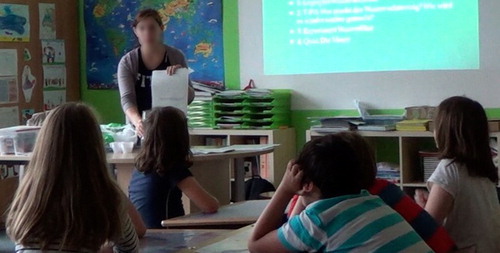
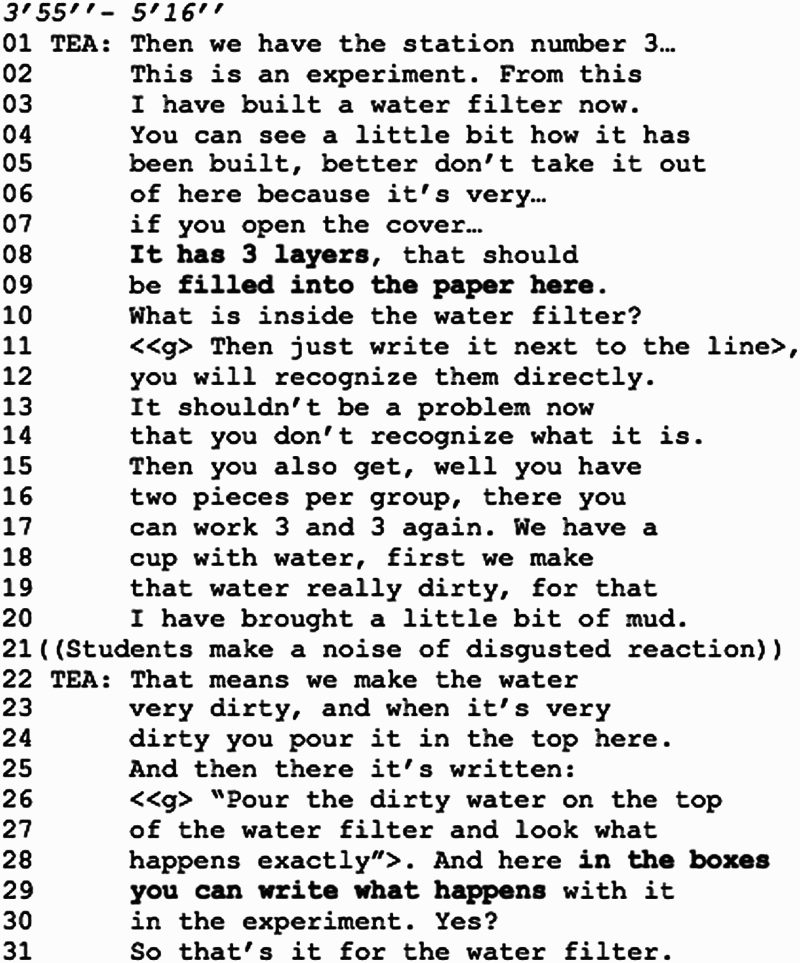
As she introduces this part of the investigations, she explains that she built a model of a water filter (line 3), and asks students not to take it apart (line 05). She explains that the filter is made of three layers, and that students need to complete a worksheet about this (line 09). She acknowledges that students might not recognise what materials are in the filter, as she explains ‘it shouldn’t be a problem that you don’t recognize what it is’ (lines 13 and 14). The overall objective, as she explains in Luxembourgish (lines 15–24), is that they should take dirty water and pour it into the filter. She then reads aloud the directions in German (lines 26–28) which reiterate her verbal, Luxembourgish, directions to pour the dirty water into the filter, and also emphasise to observe exactly what happens. She switches back to Luxembourgish next to show the box for writing their observations (lines 28–29).
The worksheet consisted of two parts (see ). The first reads ‘1. Describe the drawing. What can one find in the water filter?’, followed by a drawing of the filter including three lines. The purpose of these lines is to fill-in-the-blank with the component of each layer: stones, sand, and cotton. The second part is slightly more open, in that students need to document their observations: ‘Pour the dirty water at the top of the filter and observe exactly what happens. Write your observations in the box!’ (see ).
This excerpt is included to illustrate how this teacher moves from Luxembourgish verbal directions, to reading German directions, and then back to Luxembourgish to continue her explanation. This is a teaching practice that we have seen in numerous classrooms in Luxembourg and we begin with this excerpt for a reader to have a sense of the usage of languages in this class, and to elaborate the investigation as introduced by the teacher. We next demonstrate Pedro’s engagement with these tasks specifically.
Excerpt 2: from the periphery to the centre
Pedro and his group moved to the water filter station, introduced in Excerpt 1. They sit opposite another group at the same table to complete the tasks. During the first minutes before the teacher came over, the children distribute materials on their own. It is during this particular period, without the teacher’s presence, that Pedro’s sudden change of ‘footing’ (Goffman, Citation1981) is visible. ‘A change of footing implies a change in the alignment we take up to ourselves and the others present as expressed in the way we manage the production or reception of an utterance’ (Citation1981, p. 128). It is through this change of footing that Pedro is able to become a more active participant and engage more agentically in the investigation, acting independently and making choices (Burr, Citation2003), directly at the beginning of the group’s activities. As the students begins to work with the filter, a peer distributes the handouts, and Pedro’s footing suddenly changes as he becomes the ‘manager’ of the task. Here Pedro gives the group opposite to his the material for the ‘experiment’ (see ) (27′35″).
He seems to be the one in charge of distributing the task and he is well positioned regarding the centre of the practice. In fact, the filter is placed in front of him during the whole activity.
Pedro’s embodiment of the task is important for his involvement in the investigation, since he is limited linguistically with this group in that he is not able to use his home language (Portuguese) for meaning-making during the task, while his peers are able to, as they interact in their home language (Luxembourgish). However, none of the group speaks Portuguese, and as such Pedro cannot draw on his home language in interacting with them. Thus his embodiment of the role of ‘task manager’ emerges from his positioning, as he agentically distributes the material at the start of the investigation.
Soon after the distribution of materials Pedro is the first one to address the worksheets (see ), even though some of his groupmates are still passing them and have not looked at them (27′51″).
As he considers the task of labelling the materials in the filter, Pedro proceeds to openly state his hypothesis about the only unknown layer of the filter that seems not so obvious for the students; this is the last or third layer: cotton fibre. Pedro states that it is sugar due to its appearance, pointing at it again and addressing his peer Robert (27′56″) (see ).
Pedro’s involvement in the activity and progression to the centre of practice becomes interrupted with a focus what needs to be written on the worksheet, and soon after Pedro starts writing, he begins copying (in German) again from his peer (see ) (28′35″).
This is a practice he uses repeatedly during written tasks that appear to have only one correct answer. At this stage, some students are still passing the sheets around and the teacher has not come to this group yet. Pedro, as well as his peers, seems to have understood the priority of the data sheet, and they increase their focus on the investigation. What is noteworthy here is Pedro’s sudden change of footing again, as he becomes passive and peripheral when needing to complete the handout.
Two minutes later, when the teacher passes by, and before anyone else could speak up, Sara, one of the students at Pedro’s group told the teacher that the filter had ‘sugar’ inside (29′42″) repeating what Pedro had previously openly hypothesised. Another student named Robert said it was water, but the teacher did not comment on either suggestion, as she left to get water for the cups. Almost immediately after she left, Pedro smelled the top of the filter playfully, placing his hand over his nose to show that the filter did not smell good (see ).
Figure 12. Pedro smelling the top of the filter playfully, placing his hand over his nose to show that the filter did not smell good.
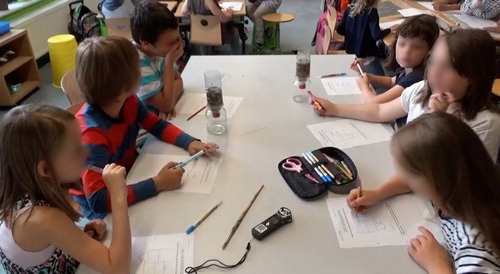
Robert follows Pedro’s actions and smells it after him. It is the first time during the experiment that Pedro extends the limits of the task, through a playful approach. Pedro missed his opportunity to address the teacher and tell her that he thought the last layer was sugar, and he instead investigates with his senses and the filter.
Pedro continues copying from Robert, who is sitting on his right (see ) for completing the handout and thus becoming again a peripheral participant.
As witnessed during a previous lesson where Pedro had to read German aloud, he does not appear confident in that language. This is further demonstrated in that he copies almost constantly from Robert, even once asking him about a letter he could not read on Robert’s paper. Pedro’s lack of confidence in German pushes him out of the centre of the practice and forces him to drastically change footing, becoming a peripheral member again, in spite of his efforts to be active and open the task. In sections that follow we will look closer at the handouts to demonstrate how Pedro completed the task. Moving from the periphery to the centre as a participant takes time, and is typically a long process. However, the participatory nature of the activity allowed Pedro to quickly change roles, and this quite drastic movement from periphery to centre is understood through the lens of footing, which can be a moment-to-moment change in participation patterns and positioning. Through Pedro’s sudden change of footing and positioning, his peripherality shifts, and his participation approaches the centre of the practice as he moves towards becoming a full participant in the interaction and the investigation. It is also his embodied action that allows him to participate as well as change his footing in his group, and this then changes his role and position in the group to access the investigation actively.
Excerpt 3: Pedro’s leadership and playful attitude as a ‘task opener’
After the students observed the water filter and began to complete the worksheet, the teacher came with two glasses with mud and polystyrene pellets (to represent objects in dirt) to pour into the top of the filters. Pedro and Laura, a girl in the other group at the station, both volunteer to be first to test the filter (see ) (30′53″) by pouring this dirty water into the top.
One can see how both take on the leader roles in their respective groups, approaching the centre of practice.
After pouring some liquid into the filter, Pedro hands the cup of dirty water to his peer, who also pours some in the filter. Pedro then moves the liquid at the top of the filter around with his pen. His playful attitude and participation stance reflect again that he is at ease with the filter experiment and dares to manipulate the objects around him, in contrast to the written assignment (see ) (32′16″).
Figure 15. Pedro asking to the teacher while pointing to the bottom of the water filter “Are there holes here?”.
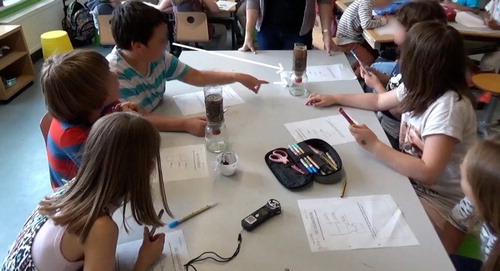
Pedro’s manipulation and playful attitude serve as a platform for his peers to ‘open the task’, as Robert again imitates him. Pedro’s attitude and sudden change of footing allow him to approach the centre of the practice, opening the task at the same time.
Soon after, Laura is the first one stating the result, which was that the water comes out from the filter looking much clearer (‘It comes out clean!’ line 7). Laura points at the bottom of the filter, where the water drips through looking clean. Instantly all her peers look at the water coming out of the filter.
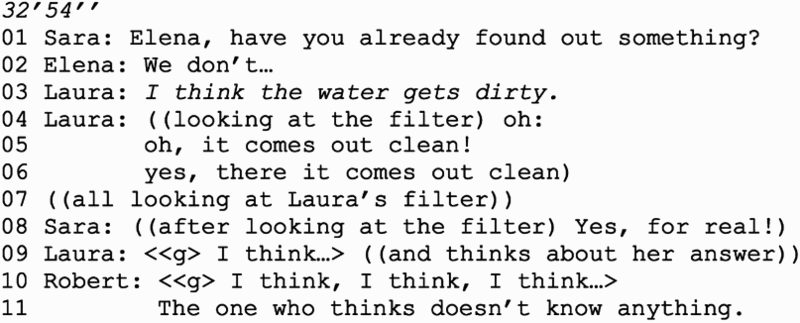
Right before the discovery, Laura tries to hypothesise: ‘I think the water will become dirty … ’ when suddenly she looks at the bottom of the filter and realises the contrary, as she states emphatically in Luxembourgish ‘It comes out clean!’ (line 05). Then she tries to state, in German, a collective answer for writing on the handout, however her hesitations (‘I think … ’ line 10) triggered Robert to question her ability to lead for the writing task (line 11), in an also playful attitude, such as the one displayed previously by Pedro, as Robert says jokingly to Laura ‘I think, I think, I think … the one who thinks doesn’t know anything’.
Soon after the teacher confirms Laura’s discovery, another student, Jana, points out to the teacher that the water comes out clean from the filter. Pedro played no role in that discovery; however, he immediately adds a question about the filter to the teacher: ‘Are there holes here?’ (see ), which the teacher confirms (line 8). This makes Pedro a participant in the discovery, since he is the one first telling the teacher about the hole and the reason why the water is coming out cleaner. Pedro is again at the centre of the practice and even holding his leading role now in front of the teacher.
Figure 16. Pedro's playful attitude here pretending to mix the dirty water at the top of the water filter.
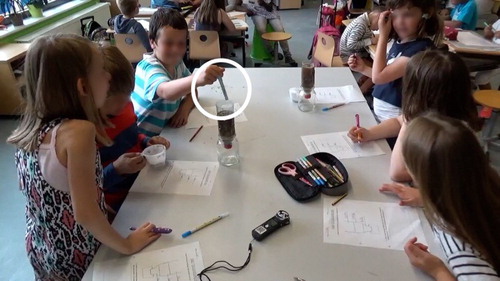
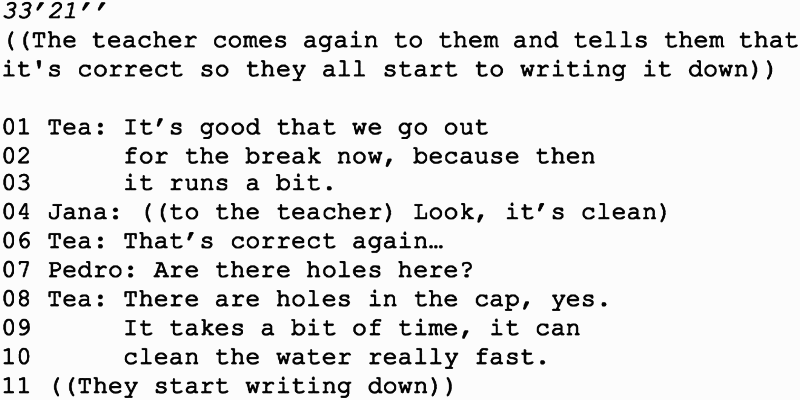
Once the results are confirmed by the teacher, the students start writing down their observations on the handouts in German. All appear engaged in writing their own description of the investigation observations, except for Pedro, who instead starts copying again from Robert, depending thus on another for completing the task. At some point, Pedro even positions himself very close to Robert’s handout and asks him to clarify a letter he cannot identify (lines 1–3 below) (see ).
Figure 17. Pedro positions himself very close to Robert's handout and asks him to clarify a letter he cannot identify.
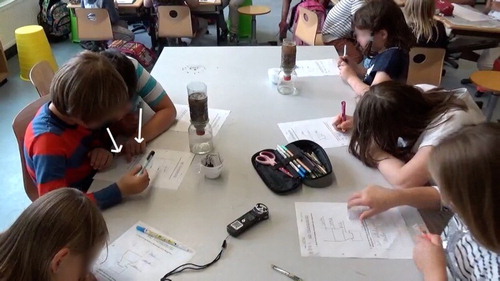

Pedro points at Robert’s worksheet and asks ‘What is that [letter]?’ (line 01), and then sees that the letter was ‘b’. It is evident that while his role was as a central participant in the investigation itself, as he took agency to not only distribute the materials but also to observe the hole in the filter and to elaborate this with his peers as well as his teacher, he struggled with the writing task in German, which we discuss in further detail next.
The final handout
In spite of consistently copying the German writing from Robert, Pedro’s handout contains several spelling mistakes. Furthermore, capitalising the first letter of a noun, a basic rule in German orthography, is not evident in his writing, another reason Pedro could see his marks lowered not only in this assignment but in future ones, as it is common practice that students lose points for incorrect spelling and capitalisation when writing German ().
Robert’s worksheet has the requested vocabulary spelled correctly in the first section, and the second section he answered ‘the dirty water gets clean’ (). In contrast, Pedro’s handout contains several mistakes and some unclear writing. Concerning the word ‘Steine’ (rocks), the first letter ‘s’ is not clearly written as a capital letter. Furthermore, the ‘n’ looks like an ‘m’. This might be caused by Pedro’s copying letter-by-letter and not reflecting on the words being copied. Finally, the word ‘sauber’ (clean) contains two spelling mistakes, there is an extra ‘a’ and the ‘e’ is missing. While these might seem minor details in German, which is perhaps not the overall focus of a science investigation, in our context, there is a strong emphasis on students writing correctly in the particular languages, and thus students are typically penalised for orthographic errors, even in subjects other than languages ().
While Pedro seems to experience difficulties writing in German, by contrast he engages actively in the investigating and manipulating for the filtering investigation. His attitude, even when playful and sometimes off-task, might have also motivated some of his peers to engage further. His positioning and attitude also made it possible to suddenly change his footing to become an active participant during the investigation. Pedro was the first one distributing the task, hypothesising about the filter’s content, and writing on his handout. Throughout this investigation, he demonstrated a playful, positive attitude, and even when the task was completed, he continued experimenting with the filter, drawing his peers in with his curiosity and further investigating in open-ended ways (43′43″) (see ).
One example of his engagement in further investigation is that after handing in their worksheets, Pedro and Laura put the filters together and squeezed them to see the water drip through, thus transforming, extending and opening the task, again in a direction they chose.
Discussion
Excerpts 2 and 3 reveal that Pedro’s positioning in his group changed depending on the structure of the tasks, and his participation increased when he was positioned to engage more directly with the materials at hand rather than being focused on written text. Pedro could for a period of time become an active participant, as he approached the centre of the practice and agentically took on a role as group leader. When he managed to transform the task to be more open, Pedro’s role and access to participation also changed; he was no longer in the periphery. He demonstrated a new leadership role, contributing to the further opening and thus appropriating the task for his peers as he further manipulated the investigations in his group. The shift in his footing and his role mediated not only his own positioning in the investigation, but also the engagement and participation of his peers and their further engagement with the science practices they were engaged in.
We documented the moment-to-moment interactions that unfolded in this unit on environmental protection, and analysis of Pedro’s interactions with his group provided a lens on how these students engaged with different science-related tasks. Pedro, as a CLD student, was clearly only peripherally engaged in tasks that focused on reading and writing with an expectation of one correct answer. His footing changed quite dramatically when the tasks became more participatory through the water filtering activity, as he drew on playful investigations to become a more central participant in the task. His science-related participation shifted to mediate his involvement in investigating the water filter, and he adopted a role of leadership with his group. We elaborated in the theoretical frameworks sections the perspective that identities are fluid and that they can shift and change in interaction, and that learning itself can be seen as involving changes in identities. The data analysis has revealed the ways in Pedro’s changed participation was observed in moment-to-moment interactions dependent on the structure of the tasks at hand. Those tasks that required a focus on reading and writing did not position him as a central participant and kept him to the periphery of the group, but when the structures were changed to involve direct manipulation of materials and discussion with peers, he was able to draw on his playful nature and his overall understandings to engage more centrally in the activities. Teachers’ potential lack of confidence regarding students’ use of home languages in science investigations, which has been identified as a supportive, meaning-making device by many studies,Footnote6 adds to the widespread lack of self-confidence about their own expertise in science. However, as Siry et al. state, ‘doing science is to learn science’ (Citation2012, p. 333) and thus practice-based approaches within more open-ended structures, where the teacher allows for students’ agentic participation (Siry, Wilmes & Haus, Citation2016), could allow for boosting this lack of confidence. The findings of this study suggest that including investigative approaches in science education that allow for diverse languages is to be taken into serious consideration as an effective approach to engage CLD students in science.
Implications and concluding points
The implications of this work extend beyond this one student, and beyond CLD children in general, to children who are at a disadvantage in science for numerous reasons (ethnicity, home language, sociocultural/economic levels, etc.). Placing more participatory activities at the centre of the science curriculum can mediate students’ roles and engagement in science (Doris, Citation1991). Pedro’s identity evolved in interaction, as he became the leader in his group, and through a ‘playful’ stance, managed to open the task so that his peers could further explore, experiment, and learn science. Implications include the value of including more open-ended situations in teaching, learning, and researching science (Siry, Citation2013) as well as implications for further study concerning participatory approaches in science with CLD students, particularly in increasingly multilingual/cultural school contexts.
Pedro’s teacher recognised the value of providing space for students to investigate, as she stated during an informal interview after the lesson that by including more experiments and manipulation she can motivate the students that are more often positioned to not participate during certain teaching structures (e.g. frontal-teaching) like Pedro. She realised that with more investigations and direct manipulation students such as Pedro (who she considered unmotivated) can be positioned to be more engaged in science lessons, shown in the following interview excerpt.
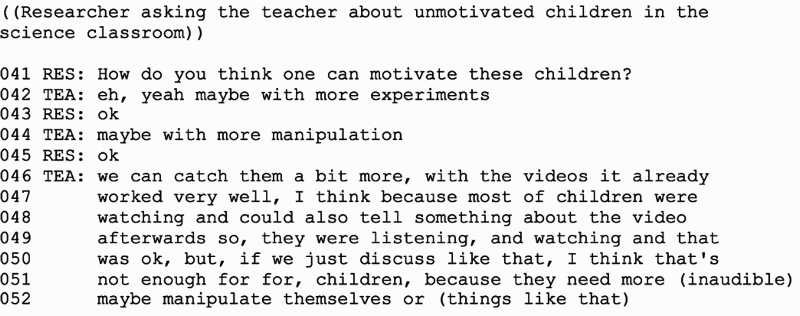
She reflected on how to motivate her less-motivated students, and considered the role of direct manipulation of materials, as she mentions her previous pedagogical use of videos about the environment (‘that’s not enough’) and makes connections to including more direct engagement with materials and investigations. Thus, the opportunity for Pedro and his classmates to engage in diverse ways around the water filter activity also supported their teacher's reflections on teaching and learning strategies that incorporate manipulation and increase student motivation.
Indeed, Pedro’s new role enabled him to ‘open’ the task assigned from the teacher, as he could unveil his potential through participation in this task: ‘Many students have unexpected educational potential that can flower in new learning environments but that remain undetected in conventional classroom settings’ (Atkin & Black, Citation2003, p. 98). The analysis of Pedro’s interactions reveals his engagement in science practices in ways that supported his investigations as well as his leadership to ‘open-up’ the hands-on task assigned by the teacher. Understanding the ways in which the different structures of the investigations (writing, reading, speaking, and doing science) shaped Pedro’s positioning to take agency and his access to making new meanings emphasises the value of providing diverse opportunities for CLD students to engage in science practices. This supports framing learning as more than improving science content knowledge, practices, and paradigms (Varelas, Settlage, & Moore Mensah, Citation2015), and underscores the perspective of science learning as occurring in and through participation in the practices of science (Moore, Evnitskaya, & Ramos de Robles, Citation2016). Adopting perspectives on learning as emerging from participation and engagement shines a light on the ways in which a CLD student such as Pedro positions himself and is positioned by others within the structures of a science investigation. It has been suggested that the ways in which science is presented to students can present problems for student access and engagement (Gurgel, Pietrocola, & Watanabe, Citation2016). Structures that focus solely on written text can marginalise students that cannot access these texts due to differing language competencies, for example, and thus including more opportunities for students such as Pedro to participate in more open practice-based investigations can lead towards more equitable opportunities for taking agency and engaging with science.
Table 1.
Disclosure statement
No potential conflict of interest was reported by the authors.
ORCID
Roberto Gómez Fernández http://orcid.org/0000-0002-6697-6511
Notes
1. Our translation: ‘The school must help all children, stimulate the strongest, encourage the less gifted, protect and support the weakest.’ Study Plan for the Primary School (MENFPS, Citation2004, p. 4).
2. SciPol:Lux project (Science Education, Innovation, and Policy in Modern Luxembourg) Project (PI: Prof. Christina Siry).
3. Pseudonyms are used for the names of all children and teachers involved in this study as part of anonymisation and protection of their identities.
4. Pedro is a Portuguese citizen, although born and raised in Luxembourg.
5. Transcription convention:
6 See research on Translanguaging and the use of home languages in the classroom, since the term ‘Translanguaging’ as understood here was forged by García (Citation2009, p. 45). Otheguy, García, and Reid define ‘translanguaging’ as ‘the deployment of a speaker’s full linguistic repertoire without regard for watchful adherence to the socially and politically defined boundaries of named (and usually national and state) languages’ (Citation2015, p. 281).
References
- Atkin, J. M., & Black, P. (2003). Inside science education reform: A history of curricular and policy change. New York, NY: Teachers College Press Columbia University.
- Burr, V. (2003). Social constructionism. London: Routledge.
- Carspecken, P. (1996). Critical ethnography in educational research: A theoretical and practical guide. New York, NY: Routledge.
- Denzin, N. K. (1970). The research act in sociology. Chicago, IL: Aldine.
- Doris, E. (1991). Doing what scientist do: Children learn to investigate their world. Portsmouth, NH: Heinemann.
- Fleury, C. (2013). Les solidarités intergénérationnelles dans une perspective des parcours de vie [The intergenerational solidarities in a lifespan perspective]. Sociologie et sociétés, 45(1), 91. doi: 10.7202/1016397
- Freeman, S., Eddy, S. L., McDonough, M., Smith, M. K., Okoroafor, N., Jordt, H., & Wenderoth, M. P. (2014). Active learning increases student performance in science, engineering, and mathematics. PNAS, 111(23), 8410–8415. doi: 10.1073/pnas.1319030111
- García, O. (2009). Emergent bilinguals and TESOL: What’s in a name? TESOL Quarterly, 43(2), 322–326. doi: 10.1002/j.1545-7249.2009.tb00172.x
- García, O., Kleifgen, J. A., & Falchi, L. (2008). From English language learners to emergent bilinguals. Equity Matters (Research Review No. 1). New York, NY: A Research Initiative of the Campaign for Educational Equity.
- Goffman, E. (1981). Forms of talk. Philadelphia: University of Philadelphia Press.
- Gómez Fernández, R. (2014). A case study of a Brazilian newcomer in a Luxembourgish school: Understanding the role of LPP in identity development. Sociolinguistic Studies, 8(2). doi:10.1558/sols.v8i2.293
- Goodwin, C. (2007). Participation, stance and affect in the organization of activities. Discourse & Society, 18(1), 53–73. doi: 10.1177/0957926507069457
- Gurgel, I., Pietrocola, M., & Watanabe, G. (2016). The role of cultural identity as a learning factor in physics: A discussion through the role of science in Brazil. Cultural Studies of Science Education, 11(2), 349–370. doi: 10.1007/s11422-014-9580-5
- Haak, D. C., HilleRisLambers, J., Pitre, E., & Freeman, S. (2011). Increased structure and active learning reduce the achievement gap in introductory biology. Science, 332(6034), 1213–1216. doi: 10.1126/science.1204820
- Harlen, W. (2012). Background resources for implementing inquiry in science and mathematics at school: Inquiry in science education. Retrieved from Montrouge, France: Fondation La main à la pâte.
- Holland, D., Lachicotte, W. J., Skinner, D., & Cain, C. (1998). Identity and agency in cultural worlds. Cambridge, MA: Harvard University Press.
- Institut national de la statistique et des études économiques du Grand-Duché de Luxembourg [STATEC]. (2016). Luxembourg in figures 2016.
- Lave, J. (1996). Teaching as learning, in practice. Mind, Culture & Activity, 3(3), 149–164. doi: 1074-9039/96/149-164
- Lave, J., & Wenger, E. (1991). Situated learning: Legitimate peripheral participation. Cambridge, UK: Cambridge University Press.
- Lee, O., Llosa, L., Jiang, F., Haas, A., O’Connor, C., & Van Booven, C. D. (2016). Elementary teachers’ science knowledge and instructional practices: Impact of an intervention focused on English language learners. Journal of Research in Science Teaching, 53(4), 579–597. doi: 10.1002/tea.21314
- Lemke, J. (1990). Talking science: Language, learning, and values. Norwood, NJ: Ablex Publishing.
- Lincoln, Y. S., & Guba, E. G. (1985). Naturalistic inquiry. Newbury Park, CA: Sage Publications.
- Lock, R. (1990). Open-ended, problem solving investigation: What do we mean and how can we use them? School Science Review, 71(256), 63–72.
- Martin, S. N., & Siry, C. (2012). Using video in science teacher education: An analysis of the utilization of video-based media by teacher educators and researchers. In B. J. Fraser, K. Tobin, & C. J. McRobbie (Eds.), Second international handbook of science education (Vol. 24, pp. 417–433). the Netherlands: Springer.
- Meyer, X. S., & Crawford, B. A. (2015). Multicultural inquiry toward demystifying scientific culture and learning science. Science Education, 99(4), 617–637. doi: 10.1002/sce.21162
- Miles, M., & Huberman, A. M. (2014). Qualitative data analysis: A methods sourcebook (3rd ed.). London: Sage Publications.
- Ministère de l’Éducation nationale, de la Formation professionnelle et des Sports [Ministry of National Education, Vocational Training and Sports]. (2004). Ajout au plan d'études: L'évaluation à l'école primaire et objectifs principaux des différentes années d'études [Addition to the study plan: The evaluation at the primary school and main goals for the different study years]. Luxembourg.
- Ministère de l’Éducation Nationale, de l’Enfance et de la Jeunesse [Ministry of National Education, Childhood and Youth]. (2015). Statistiques globales et analyse des résultats scolaires: Enseignement fondamental: Cycles 1 à 4 – Éducation différenciée – Année scolaire 2013/2014 [Overall statistics and analysis of educational attainment: Primary education: Cycles 1 to 4 – special education –Year 2013/2014]. Luxembourg.
- Ministère de l’Éducation Nationale, de l’Enfance et de la Jeunesse [Ministry of National Education, Childhood and Youth]. (2016). Les chiffres clés de l’éducation nationale: Statistiques et indicateurs 2014/2015 [Key figures for national education: Statistics and indicators 2014/2015]. Luxembourg.
- Ministère de l’Éducation Nationale, de l’Enfance et de la Jeunesse [Ministry of National Education, Childhood and Youth], & Council of Europe. (2006). Profil de la politique linguistique éducative: Grand-Duché de Luxembourg [Language education policy profile: Grand Duchy of Luxembourg]. Strasbourg/Luxembourg.
- Moore, E., Evnitskaya, N., & Ramos de Robles, S. (2016). Teaching and learning science in linguistically diverse classrooms. Cultural Studies of Science Education. doi: 10.1007/s11422-016-9783-z
- The Organisation for Economic Co-operation and Development. (2013). PISA 2012 results: Excellence through equity: Giving every student the chance to succeed (Volume II). Paris: OECD Publishing. doi: 10.1787/19963777
- The Organisation for Economic Co-operation and Development. (2016). PISA 2015 results: Excellence and equity in education (volume I). Paris: OECD Publishing. doi: 10.1787/19963777
- Otheguy, R., García, O., & Reid, W. (2015). Clarifying translanguaging and deconstructing named languages: A perspective from linguistics. Applied Linguistics Review, 6(3), 281–307. doi: 10.1515/applirev-2015-0014
- Rogoff, B. (1994). Developing understanding of the idea of communities of learners. Mind, Culture, and Activity, 1(4), 209–229.
- Sacks, H. (1995). Lectures on conversation (Vol. I). G. Jefferson & E. A. Schegloff (Eds.). Padstow: Blackwell Publishing.
- Siry, Christina. (2013). Exploring the Complexities of Children’s Inquiries in Science: Knowledge Production Through Participatory Practices. Research in Science Education, 43(6), 2407–2430. http://dx.doi.org/10.1007/s11165-013-9364-z
- Siry, C., Wilmes, S., & Haus, J. (2016). Examining children's agency within participatory structures in primary science investigations. Learning, Culture and Social Interaction, 10, 4–16.
- Siry, C., Ziegler, G., & Max, C. (2012). ‘‘Doing science’’ through discourse-ininteraction: Young children’s science investigations at the early childhood level. Science Education, 96, 311–326.
- Stake, R. E. (1995). The art of case study research. Thousand Oaks, CA: Sage Publishing.
- Stromholt, S., & Bell, P. (2017). Designing for expansive science learning and identification across settings. Cultural Studies of Science Education. Advance online publication. doi: 10.1007/s11422-017-9813-5
- Stroupe, D. (2014). Examining classroom science practice communities: How teachers and students negotiate epistemic agency and learn science-as-practice. Science Education, 98(3), 487–516. doi: 10.1002/sce.21112
- Tobin, K. (2013). A sociocultural approach to science education. Magis: Revista Internacional de Investigación en Educación, 6(12), 19–35.
- Valentova, M., & Berzosa, G. (2012). Attitudes toward immigrants in Luxembourg. Do contacts matter? Revue Internationale de Sociologie, 22(2), 341–363. doi: 10.1080/03906701.2012.696976
- Vang, Christopher T. (2005). Minority students are far from academic success and still at-risk in public schools. Multicultural Education, 12(4), 9.
- Varelas, M., Settlage, J., & Moore Mensah, F. (2015). Explorations of the structure-agency dialectic for framing equity in science education. Journal of Research in Science Teaching. doi: 10.1002/tea.21230
- Weber, J. J. (2008). Safetalk revisited, or: Language and ideology in Luxembourgish educational policy. Language and Education, 22(2), 155–169. doi: 10.2167/le736.0
- Wilmes, S. E. D., Siry, C., Gómez Fernández, R., & Gorges, A. (2018). Reconstructing science education within the language | science relationship: Reflections from multilingual contexts. In L. A. Bryan & K. Tobin (Eds.), 13 Questions. Reframing education's conversation: Science (Vol. 442, pp. 251–266). New York: Peter Lang.
- Wortham, S. (1996). Mapping deictics: A technique for discovering teachers’ footing. Journal of Pragmatics, 25(3), 331–348. doi: 10.1016/0378-2166(94)00100-6

